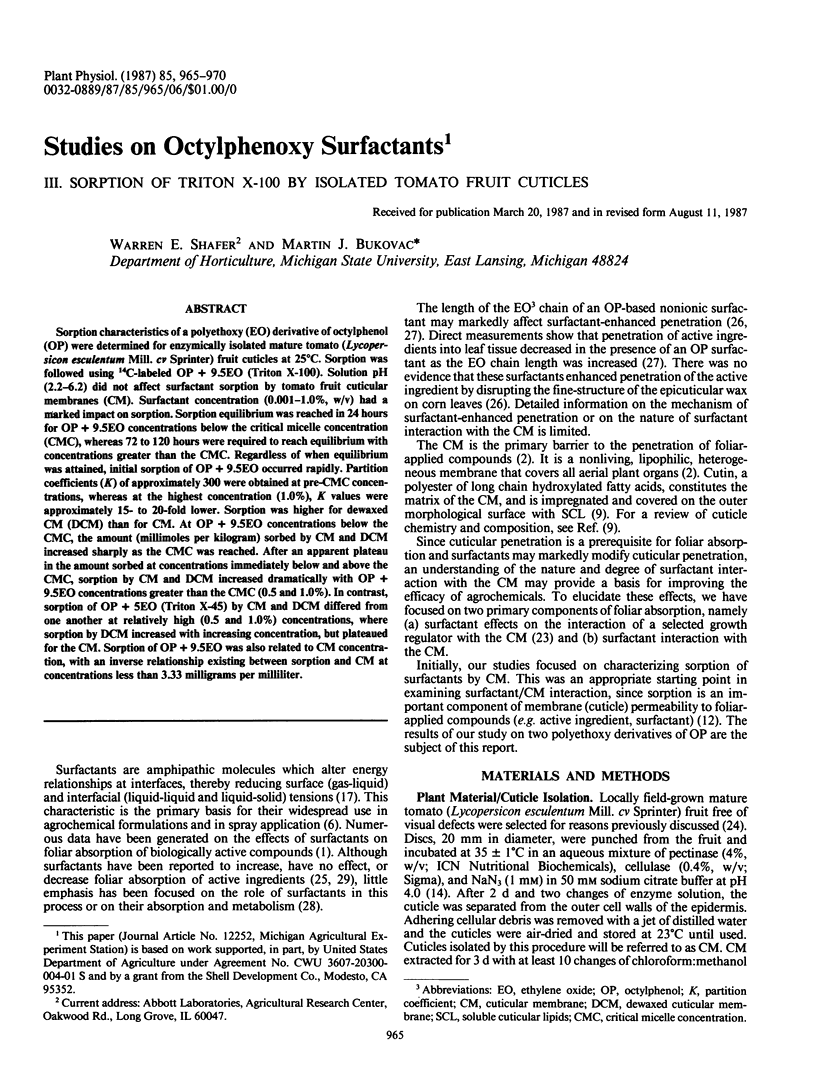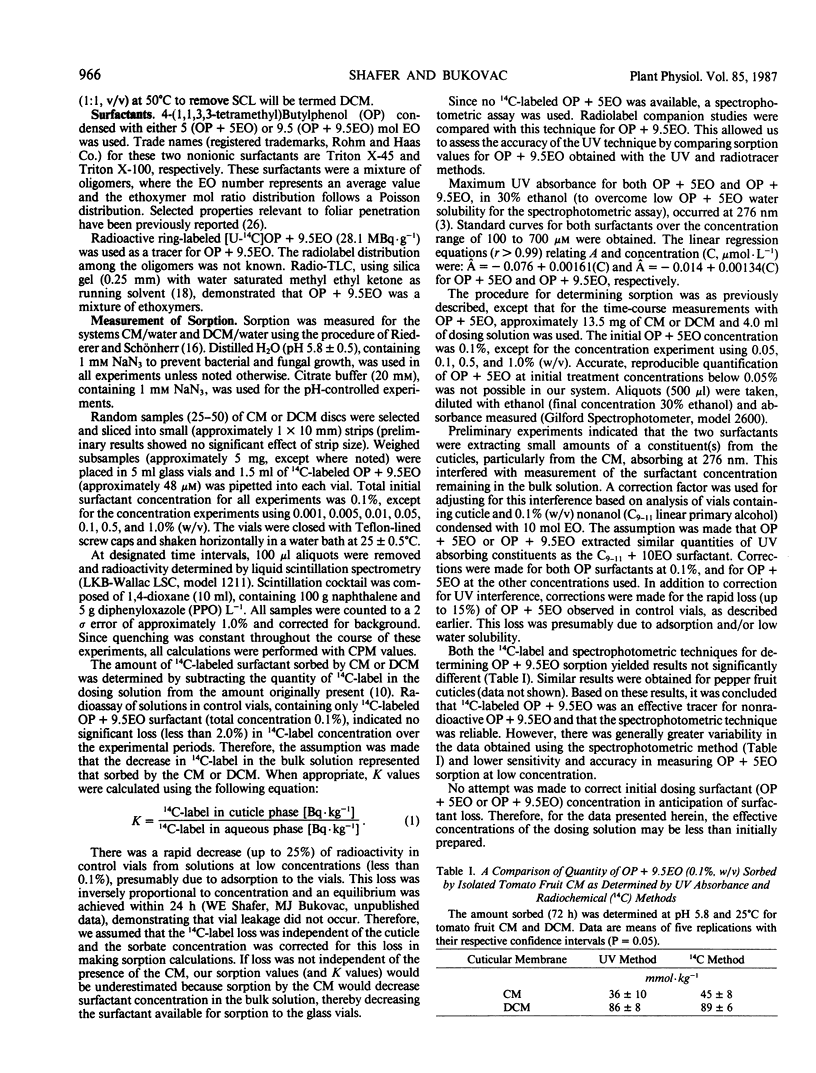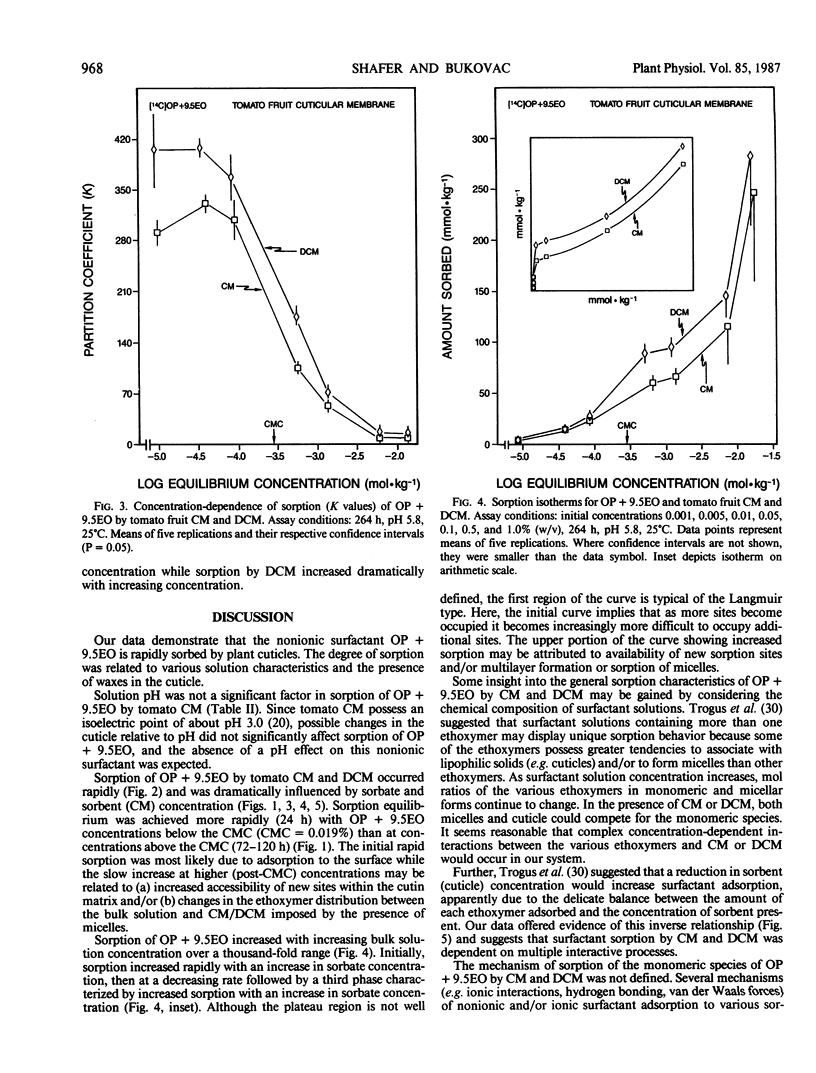Abstract
Sorption characteristics of a polyethoxy (EO) derivative of octylphenol (OP) were determined for enzymically isolated mature tomato (Lycopersicon esculentum Mill. cv Sprinter) fruit cuticles at 25°C. Sorption was followed using 14C-labeled OP + 9.5EO (Triton X-100). Solution pH (2.2-6.2) did not affect surfactant sorption by tomato fruit cuticular membranes (CM). Surfactant concentration (0.001-1.0%, w/v) had a marked impact on sorption. Sorption equilibrium was reached in 24 hours for OP + 9.5EO concentrations below the critical micelle concentration (CMC), whereas 72 to 120 hours were required to reach equilibrium with concentrations greater than the CMC. Regardless of when equilibrium was attained, initial sorption of OP + 9.5EO occurred rapidly. Partition coefficients (K) of approximately 300 were obtained at pre-CMC concentrations, whereas at the highest concentration (1.0%), K values were approximately 15- to 20-fold lower. Sorption was higher for dewaxed CM (DCM) than for CM. At OP + 9.5EO concentrations below the CMC, the amount (millimoles per kilogram) sorbed by CM and DCM increased sharply as the CMC was reached. After an apparent plateau in the amount sorbed at concentrations immediately below and above the CMC, sorption by CM and DCM increased dramatically with OP + 9.5EO concentrations greater than the CMC (0.5 and 1.0%). In contrast, sorption of OP + 5EO (Triton X-45) by CM and DCM differed from one another at relatively high (0.5 and 1.0%) concentrations, where sorption by DCM increased with increasing concentration, but plateaued for the CM. Sorption of OP + 9.5EO was also related to CM concentration, with an inverse relationship existing between sorption and CM at concentrations less than 3.33 milligrams per milliliter.
Full text
PDF





Selected References
These references are in PubMed. This may not be the complete list of references from this article.
- Orgell W. H. The Isolation of Plant Cuticle with Pectic Enzymes. Plant Physiol. 1955 Jan;30(1):78–80. doi: 10.1104/pp.30.1.78. [DOI] [PMC free article] [PubMed] [Google Scholar]
- Riederer M., Schönherr J. Accumulation and transport of (2,4-dichlorophenoxy)acetic acid in plant cuticles: I. Sorption in the cuticular membrane and its components. Ecotoxicol Environ Saf. 1984 Jun;8(3):236–247. doi: 10.1016/0147-6513(84)90027-7. [DOI] [PubMed] [Google Scholar]
- Scheule R. K., Gaffney B. J. Reconstitution of membranes with fractions of triton X-100 which are easily removed. Anal Biochem. 1981 Oct;117(1):61–66. doi: 10.1016/0003-2697(81)90691-6. [DOI] [PubMed] [Google Scholar]
- Schönherr J. Plant Cuticles Are Polyelectrolytes with Isoelectric Points around Three. Plant Physiol. 1977 Feb;59(2):145–150. doi: 10.1104/pp.59.2.145. [DOI] [PMC free article] [PubMed] [Google Scholar]
- Shafer W. E., Bukovac M. J. Effect of Acid treatment of plant cuticles on sorption of selected auxins. Plant Physiol. 1987 Mar;83(3):652–656. doi: 10.1104/pp.83.3.652. [DOI] [PMC free article] [PubMed] [Google Scholar]
- Shafer W. E., Schönherr J. Accumulation and transport of phenol, 2-nitrophenol, and 4-nitrophenol in plant cuticles. Ecotoxicol Environ Saf. 1985 Oct;10(2):239–252. doi: 10.1016/0147-6513(85)90071-5. [DOI] [PubMed] [Google Scholar]
- Szewczuk M. R., Wade A. W. Age-related strain differences in the development of auto-anti-idiotypic antibody regulation in the splenic and mucosal-associated lymphoid systems. Gerontology. 1985;31(4):251–262. doi: 10.1159/000212708. [DOI] [PubMed] [Google Scholar]


